




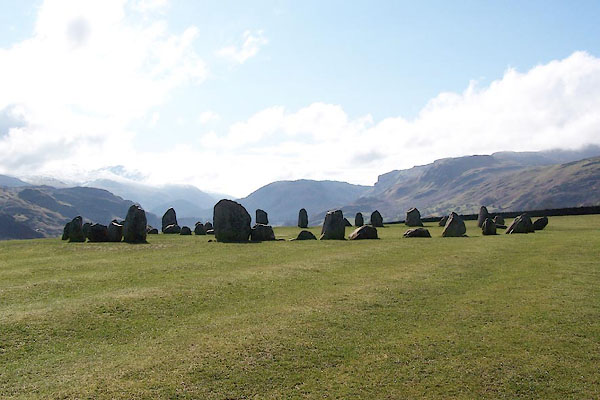
BQG50.jpg (taken 14.3.2009)
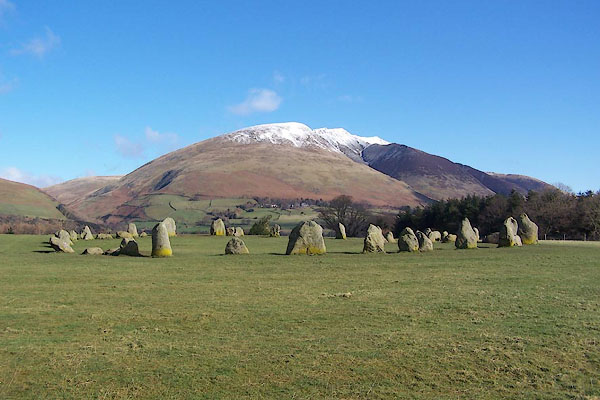
BQG49.jpg (taken 14.3.2009)
placename:- Druidical Circle
placename:- Druid Stones
Lay vast and edgeways; like a dismal cirque
Of Druid stones, upon a forlorn moor,
When the chill rain begins at shut of eve,
In dull November, and their chancel vault,
The Heaven itself, is blinded throughout night.
Each one kept shroud, nor to his neighbour gave
Or word, or look, or action of despair."
placename:- Druid Stones
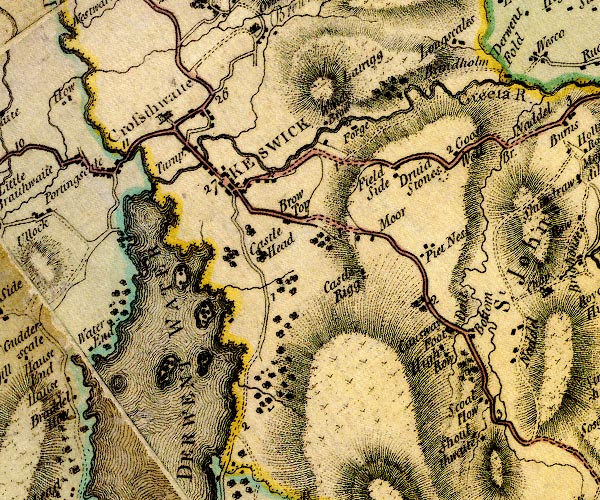
D4NY22SE.jpg
"Druid Stones"
circle of 7 spots
item:- Carlisle Library : Map 2
Image © Carlisle Library
 goto source
goto sourcePage 110:- "... [from the front of Mr. Wren's house] In a field on the left, near the second mile-post, stands conspicuous, the above-mentioned wide circus of rude stones; the awful monument of the barbarous superstition which enslaved the minds of ancient times. Mr. Pennant had in his possession an excellent drawing of these druidical remains."
 goto source
goto sourceAddendum; Mr Gray's Journal, 1769
Page 208:- "... After dinner walked up the Penrith road two miles, or more, and turning into a cornfield to the right, called Castle-rigg, saw a druid circle of large stones, 108 feet in diameter, the biggest not eight feet high, but most of them still erect: they are fifty in number [1]."
"[1] See this piece of antiquity more fully described, with a plate annexed, by Mr. Pennant, in his second tour of Scotland, 1772, page 38."
placename:- Druids Temple
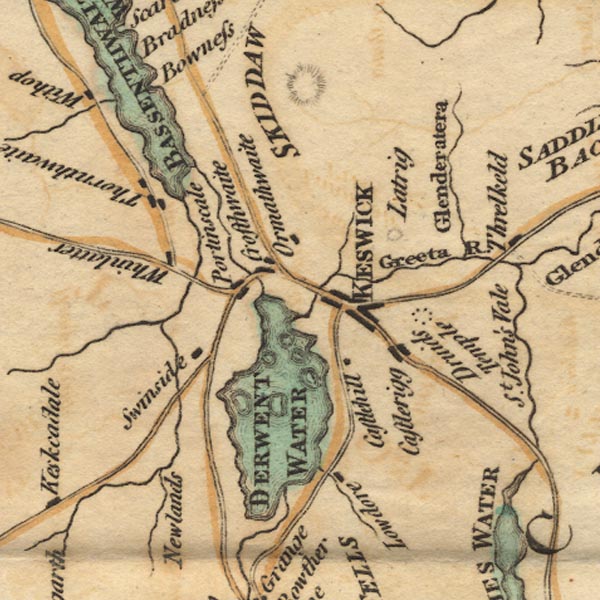
Ws02NY22.jpg
Circle of seven dots near Castlerigg village. "Druids Temple"
item:- Armitt Library : A1221.1
Image © see bottom of page
 goto source
goto sourcePage 62:- "About a quarter of a mile farther on the left is Castrigg, or Castle-Rigg: here is a druidical monument, consisting of a circle of fifty-two large stones. This temple (as they all commonly get that name) differs from all I have seen, in having on the Eastern side an inclosure formed within the circle; this inclosure is on the form of an oblong-square, one of the shorter sides of which is formed by part of the circle, and its dimensions are nearly four yards by two."
"It is amazing how our rude forefathers could remove such large stones, and place them in regular order! The stones of which this is composed are of a kind not to be found within many miles of this place; it is situated upon a steep hill, and we know they were unacquainted with, not only the use of every mechanic power, but even of carriages: had they even known these, we know of no carriage capable of transporting, or even bearing the weight of these enormous masses."
placename:- Carles
 goto source
goto sourcePage 181:- "..."
"... In the neighbourhood of this place [Castlerigg], on the right hand of the road from Keswic to Penrith, is a collection of stones of unequal size"
 goto source
goto sourcePage 182:- "and shape, about 39 yards diameter, and on the east side within the circle or area two or more rows of like stones, including a space about eight yards by four. Stukely desribes it as very intire, 100 feet diameter, consisting of 40 stones, some very large. At the east end a grave, made of such other stones, in the very east point of the circle, and within it not a stone wanting, though some are removed out of their original situation. They call it the Carles, and corruptly Castle rigg. There seemed to be another lower in the next pasture towards the town."
"..."
"... About a mile and an half from Keswic on a high hill in a field called the Castle, is a druidical circle of stones, tending to an oval 35 yards diameter from north to south and near 30 from east to west. These stones are at present 40, but many fallen. At the north end are two five feet high; two more of nearly the same height at the south end, and one at the east near seven feet. On this side is the Kistvaen of great stones."
 goto source
goto source"[Keswick] ... About 2 miles from the town is a druidical monument, on a plain on the summit of a hill; it is composed of stones of various forms, rough and unhewn, for the most part granite. They are 50 in number, and form a circle of about 30 paces in diameter, within which are 10 stones placed in an oblong square, supposed to have been used as an altar. The stones are of various sizes, some of the largest being near 8 feet high, and 15 in circumference. ..."
 goto source
goto sourcePage 81:- "THE ANTIQUITIES."
"A Druidical Circle, 100 feet by 108 in diameter, in a field adjoining the old Penrith road, at the top of the hill, a mile and a half from Keswick."
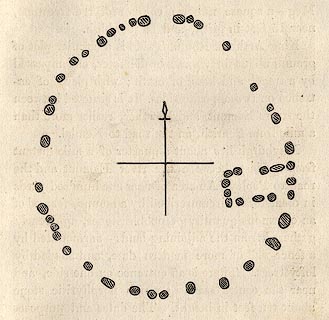 click to enlarge
click to enlargeOT2E10.jpg
"It is formed by rough cobble stones of various sizes, similar to what are scattered over the surface, and imbedded in the diluvium of the adjacent grounds. The largest stands upwards of seven feet in height, and may weigh about eight tons."
item:- JandMN : 48.11
Image © see bottom of page
placename:- Druid's Circle
 goto source
goto sourcePage 59:- "..."
"THE DRUID'S CIRCLE."
"'A few rude monuments of mountain stone
Survive: all else is swept away.'"
"This religious monument is situated on the top of a lone hill, one mile and three quarters on the road from Keswick to Penrith, in the centre of the loftiest mountains in the district, away from the sight and sound of human life. It occupies a circular area three hundred and thirty-six feet in circumference, and one hundred and fourteen feet in diameter, surrounded by thirty-eight granite stones"
 goto source
goto sourcePage 60:- "from three to eight feet high, having at the east end ten other stones, forming three sides of a square. From these stones is seen the whole encircling country; Skiddaw and Blencathra to the north present their deep-chasmed and precipitous fronts; the Dodds, Wanthwaite Pikes, with the savage dale of Naddle, shut up the scene to the south; and to the west, the fells beyond Keswick rear their majestic and undulating summits to the clouds; whilst on the east, the dreary waste of Hutton Moor is over-topped by the blue summit of Cross Fell. It was amidst such scenes as these that the Druid sage warmed into piety the hardy tempers of the Britons, and employed the solemnity of nature to aid the sanctity of religion: for"
"'There his temple rose! no fretted aisle,
No vaulted roof adorn'd the simple pile,
But clouds above them, and around the wood -
Roofless and vast the circle columns stood!
Such relics still the wondering shepherd sees
Where ocean rocks the storm-clad Hebrides:
Where Keswick's lake expands its glassy breast,
Or Mona's cliffs conceal the eaglet's nest;
Or where dim silence holds its spectral reign,
O'er Scotia's heaths and Sarum's lonely plain.
Times spares them still - to tell how short the span
Assign'd to earth's uncertain wanderer - man;
How long his works, like summer's twilight ray,
Outlive the sunset of his own decay!'"
placename:- Druid Stones
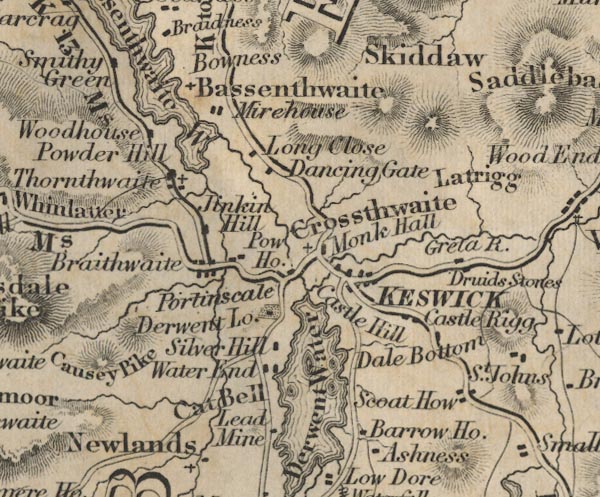
FD02NY22.jpg
"Druid Stones"
item:- JandMN : 100.1
Image © see bottom of page
placename:- Druid Stones
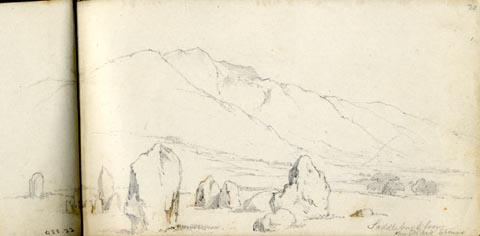 click to enlarge
click to enlargeAS0222.jpg
"Saddleback from / the Druid Stones"
page number "20"
item:- Armitt Library : 1958.488.22
Image © see bottom of page
 goto source
goto sourceGentleman's Magazine 1843 part 2 p.362 "... The situation and aspect of the Druidical temple near Keswick is in every respect similar to this [Swwinside], except the rectangular recess, formed by ten large stones, which is peculiar to Keswick."
placename:- Druid Stones
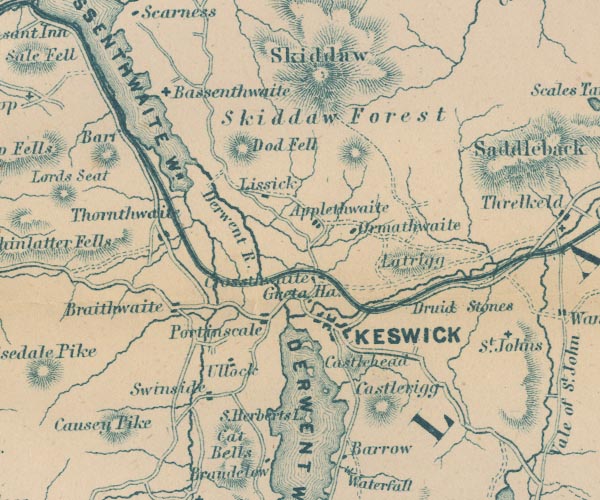
GAR2NY22.jpg
"Druid Stones"
no symbol
item:- JandMN : 82.1
Image © see bottom of page
placename:- Druidical Circle
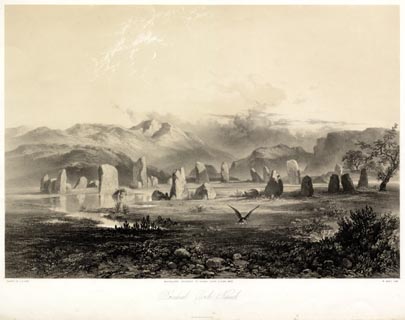 click to enlarge
click to enlargePYN214.jpg
"PAINTED BY J. B. PYNE. / W. GAUCI LITH. / MANCHESTER, PUBLISHED BY THOMAS AGNEW & SONS, 1853. / Druidical Circle, Keswick. / M & N HANHART IMPT."
item:- Armitt Library : A6678.15
Image © see bottom of page
item:- sacrifice; treasure; counting a stone circle
 goto source
goto sourcePage 94:- "... the Druids' Temple, a mile and a-half from Keswick. This very well-preserved memorial of antiquity stands in a field, near the entrance of St. John's Vale. The stones, forty-eight in number, form an oval; and there is a peculiarity in this case which distinguishes it from all other Druidical monuments extant in England. On the eastern side, within the circle, there is a small recess formed by ten stones, making an oblong square. As Southey observed, the spot is the most commanding that could be chosen, short of a mountain side; and it is indeed nearly surrounded by mountains, which it recognises in their true forms, from the levels,- with the exception of the plain towards Penrith,- being sunk out of view. The old legend about the last human sacrifice of the Druids may belong to any of the monuments of that age in the district; and it is probably claimed for them all. According to that old story; when some people settled in a clearing of the woods, beside a river, somewhere to the south of the district, the priests took up their station further north, among the mountains, where there were plenty of stones fit and ready for their temple. After a time, a fever laid waste the lower"
 goto source
goto sourcePage 95:- "settlement; and the oracle demanded a sacrifice to appease the divine wrath. The lot fell on a young girl who was betrothed: and, on an appointed day, she was conveyed, with all the ceremonies, to the temple. A small hut of wickerwork, like a large beehive, was found set up on the western side of the temple. The girl was led into the circle, and placed in the midst, while the dedication proceeded. We are even told that she was adorned with an oak garland, and held mistletoe in her hand. The whole population was looking on from a distance: but it must have been within reasonable reach, as every one was required to contribute a stick to the fire. The wretched lover saw all from afar; and he daringly resolved,- let the god be as wrathful as he pleased,- not to contribute so much as a twig to the burning of his beloved. She was seen to enter the door, which was next the circle; and then the priest closed it up, and heaped the dried leaves and sticks that were brought all round the hut. The arch-druid meantime was procuring fire from two pieces of wood. He succeeded, and set the pile in a blaze. In this moment of desperation, the lover saw every mountain round give forth a great cataract; and all the floods gushed to the temple as to a centre, and made an island of the little hut,- returning when they had extinguished the fire. The victim came forth, with not a hair singed, and not a leaf of her garland withered. The arch-druid, skilled to interpret thunder, seems to have understood in this case the voice of waters; for he announced that, henceforth, the god would have no more human sacrifices. Any resident who is sufficiently familiar with"
 goto source
goto sourcePage 96:- "the country people to get them to speak their minds fully, will find that they still hold to the notion that nobody can count the druid stones correctly; and also that a treasure is buried under the largest stone. As to the first, there are, in most such circles, some smaller stones cropping out of the ground which some visitors will, and others will not, include among those of the circle. ... As for the treasure, can any one prove that it is not there? Nobody wants to undermine the stone, to get rid of the tradition: so our neighbours are like the Arabs at Petra, who have been shooting with sling, bow, and matchlock, for a thousand years, at the urn, where they are sure Pharaoh's treasure is,- in its niche in the rock temple. For a thousand years, they have failed to bring it down, and are determined that no European shall. And no European would dismantle the temple to disabuse the Arabs; and so the tradition and the urn stand untouched. So may it be for ages to come with ... the giant of eight tons' weight that presides over the Keswick circle!"
 click to enlarge
click to enlargeHB0619.jpg
item:- Armitt Library : ALPS279
Image © see bottom of page
placename:- Druid Circle
item:- moonlight
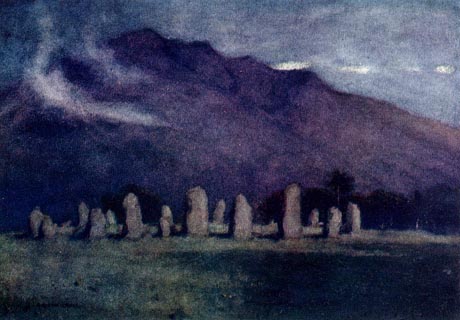 click to enlarge
click to enlargeHC0151.jpg
Opposite p.150 of The English Lakes, painted by Alfred Heaton Cooper, described by William T Palmer.
printed at tissue opposite the print:- "DRUID CIRCLE, NEAR KESWICK / Moonlight"
item:- JandMN : 468.51
Image © see bottom of page
placename:- Druidical Circle, The
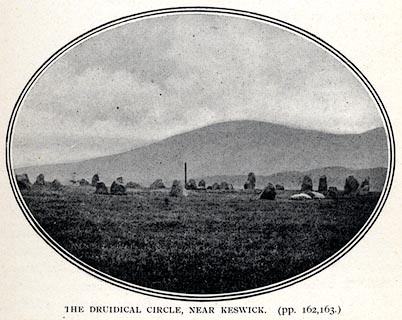 click to enlarge
click to enlargePS1E60.jpg
On p.163 of Pearson's Gossipy Guide to the English Lakes and Neighbouring Districts.
printed at bottom:- "THE DRUIDICAL CIRCLE, NEAR KESWICK (pp.162, 163)."
item:- Armitt Library : A1188.67
Image © see bottom of page
 click to enlarge
click to enlargeBGG147.jpg
Included on p.154 of Lakeland and Ribblesdale, by Edmund Bogg.
item:- JandMN : 231.47
Image © see bottom of page
placename:- Druid's Circle
 click to enlarge
click to enlargeSYL145.jpg
On p.189 of Sylvan's Pictorial Guide to the English Lakes.
printed at bottom:- "DRUID'S CIRCLE NEAR KESWICK"
item:- Armitt Library : A1201.45
Image © see bottom of page
placename:- Druids' Stones
 click to enlarge
click to enlargePR0045.jpg
vol.3 pl.36 in the set of prints, Westmorland, Cumberland, Durham and Northumberland Illustrated.
printed at bottom left, right, centre:- "T. Allom. / H. Adlard. / DRUIDS' STONES, NEAR KESWICK."
item:- Dove Cottage : 2008.107.45
Image © see bottom of page
placename:- Druidical Circle
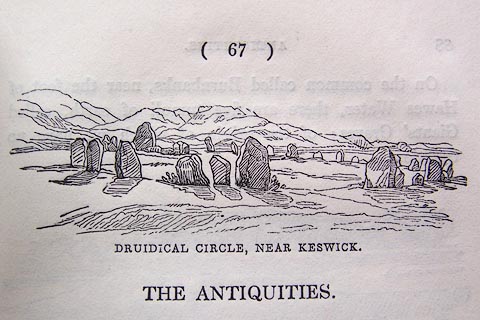 click to enlarge
click to enlargeO80E18.jpg
On p.67 of A Descriptive Guide of the English Lakes, by Jonathan Otley, 8th edition, 1849.
item:- Armitt Library : A1180.19
Image © see bottom of page
placename:- Druid's Monument
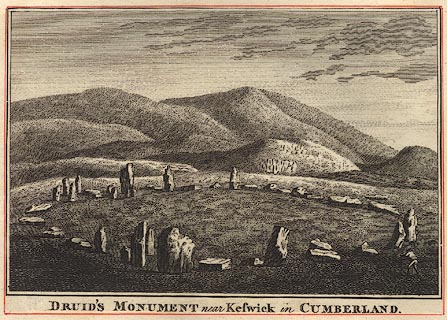 click to enlarge
click to enlargeBMZ94.jpg
Pasted in the Lowther scrapbook, vol.3; between pp.90-91.
printed at bottom:- "DRUID'S MONUMENT near Keswick in CUMBERLAND"
item:- Dove Cottage : Lowther.60
Image © see bottom of page
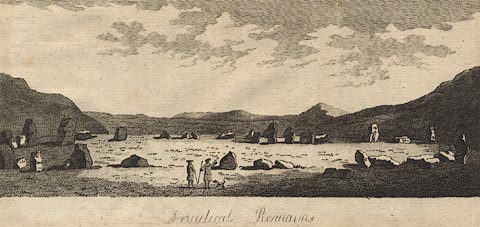 click to enlarge
click to enlargeBMZ02.jpg
This image is engraved on the same plate as Long Meg and her Daughters.
Pasted in the Lowther scrapbook, vol.3; between pp.90-91.
printed at bottom:- "Druidical Remains"
item:- Dove Cottage : Lowther.57
Image © see bottom of page

Click to enlarge
BQG51.jpg (taken 14.3.2009)

Click to enlarge
BQG52.jpg (taken 14.3.2009)
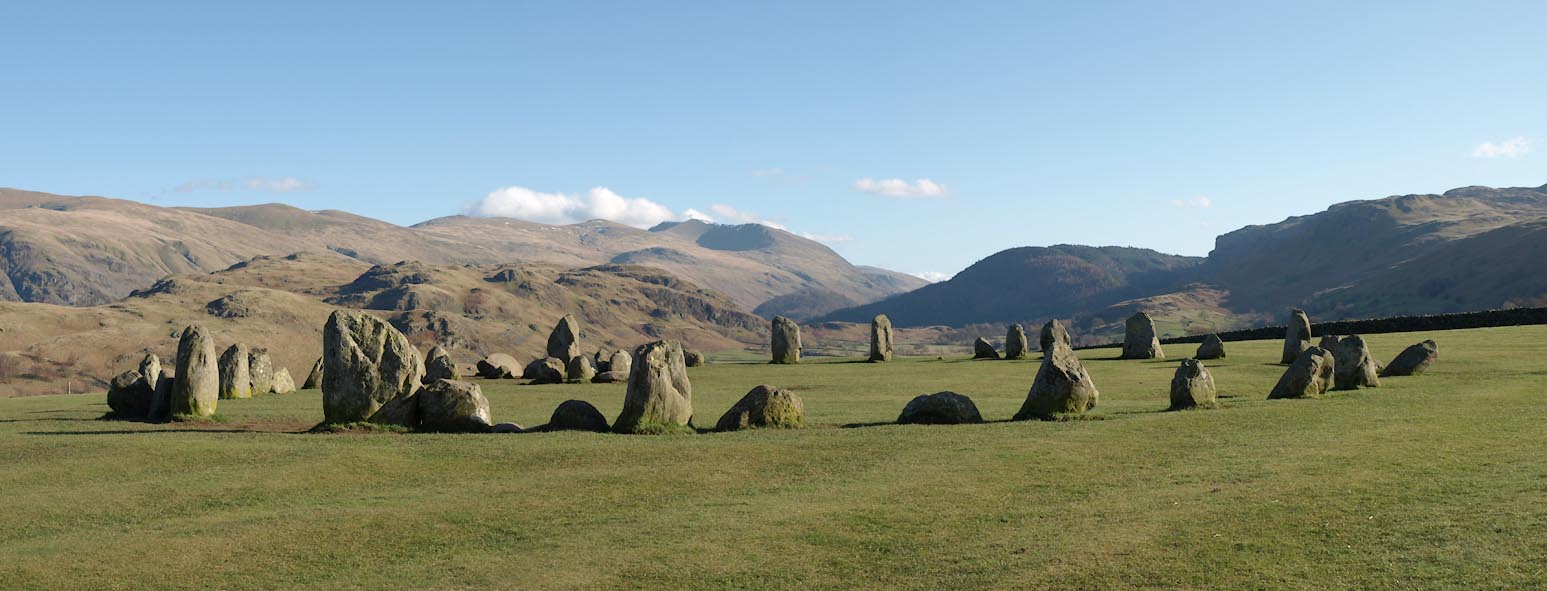
Click to enlarge
BUF98.jpg (taken 18.3.2011)

Click to enlarge
BUF99.jpg (taken 18.3.2011)

Click to enlarge
BUG32.jpg All round from the middle.
(taken 18.3.2011)
Thom, A: 1967: Megalithic Sites in Britain: Oxford University Press (Oxford, Oxfordshire)
Burl, H A W: 1976: Stone Circles of the British Isles: Yale University Press (United States)
